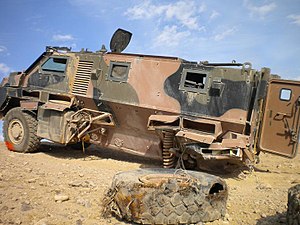V-hull
Appearance

The V-hull is a type of
armored personnel carriers (APCs), infantry mobility vehicles, infantry fighting vehicles (IFVs) and MRAPs. The design originated in the 1970s with vehicles such as the iconic Casspir used extensively during the South African Border War, Leopard security vehicle[1] used in the Rhodesian Bush War[2] and South African armored vehicle company Land Systems OMCs and Buffels.[3]
Design

The purpose of V-hulls is to increase vehicle and crew
armor at an angle, it increases the amount of material a ballistic projectile must pass through in order to penetrate the vehicle, and increases the chance of deflection
.
V-hulls are incorporated in armored vehicle designs in several different ways. Many vehicles, such as the
suspension
components to be sacrificed in an attack, while maintaining the safety of the crew.
Gallery
-
The Rhodesian Leopard security vehicle, one of the first V-hull vehicles.
-
Terrängbil m/42 KP early V-hull vehicle and the first APC in the Swedish armed forces, in use 1942–1990. It saw combat during the Congo crisis.
-
Force Protection's Cougar hit by an Improvised explosive device (IED) in Iraq; all crew survived.
-
Adrive train and utility bins were destroyed, but the hullis intact and the crew survived with only minor injuries.
See also
References
- ^ "Leopard - Land Mine Resisting Vehicle". Retrieved 2008-07-18.
- ^ "The Echos of an African War Archive". Archived from the original on 2008-09-18. Retrieved 2008-07-18.
- ^ "MachineDesign.com: Tough enough to take on land mines". Archived from the original on 2007-08-12. Retrieved 2007-07-01.
- ^ "Force Protection, Inc. - In the News". Archived from the original on 2007-09-27. Retrieved 2007-07-01.
- ^ Wood, David (2007-02-15). "Marines to trade in vulnerable Humvees". The Seattle Times.
- ^ "Defense Review - DefRev First Look: BAE Systems RG33 Series MRAP Vehicles". Archived from the original on 2007-09-27. Retrieved 2007-07-01.






